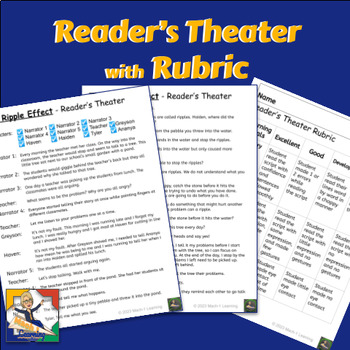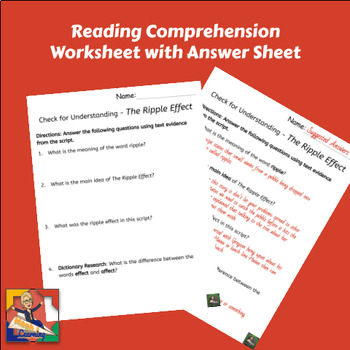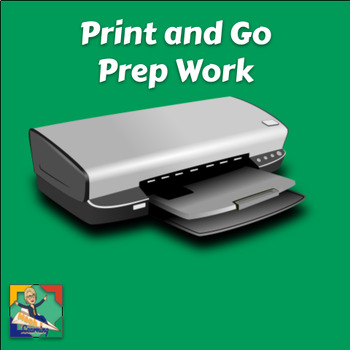Reader's Theater - The Ripple Effect (SEL) A Parable for Petty Arguments
Mach 1 Learning
17 Followers
Grade Levels
3rd - 5th, Homeschool
Subjects
Resource Type
Standards
CCSSRL.3.2
CCSSRL.4.2
CCSSRL.5.2
CCSSRF.3.4
CCSSRF.4.4
Formats Included
- PDF
Pages
10 pages
Mach 1 Learning
17 Followers
What educators are saying
It was an easy read and I was able to use it as a Social Emotional Learning reading passage in a class with many needs.
Description
Is your classroom arguing seeming to grow? Then your students are experiencing The Ripple Effect. This reader's theater is a great social and
emotional lesson (SEL) to teach students how to let go of your small problems so you can focus on more important things.
The story about The Ripple Effect is something we can apply to our lives. We bring our problems from home to school. They can often affect our behavior during the day. When we negatively impact other people, the ripple starts to spread out. After reading, there is a check for understanding work sheet.
What is included:
- Readers Theater - The Ripple Effect (11 parts)
- Rubric for Readers Theater
- Comprehension Worksheet
- Comprehension suggested Answer sheet
- Bonus: Acronym Poster for Affect vs Effect
- Common Core Standards
Common Core Standards
Third Grade
- RL.3.2 Recount stories, including fables, folktales, and myths from diverse cultures; determine the central message, lesson, or moral and explain how it is conveyed through key details in the text.
- RF.3.4 Read with sufficient accuracy and fluency to support comprehension.
- SL.3.2 Determine the main ideas and supporting details of a text read aloud or information presented in diverse media and formats, including visually, quantitatively, and orally.
Fourth Grade
- RL.4.3 Describe in depth a character, setting, or event in a story or drama, drawing on specific details in the text (e.g., a character’s thoughts, words, or actions).
- RF.4.4 Read with sufficient accuracy and fluency to support comprehension.
- SL.4.4 Report on a topic or text, tell a story, or recount an experience in an organized manner, using appropriate facts and relevant, descriptive details to support main ideas or themes; speak clearly at an understandable pace.
Fifth Grade
- RL.5.2 Determine a theme of a story, drama, or poem from details in the text, including how characters in a story or drama respond to challenges or how the speaker in a poem reflects upon a topic; summarize the text.
- RF.5.4 Read with sufficient accuracy and fluency to support comprehension.
- SL.5.2 Summarize a written text read aloud or information presented in diverse media and formats, including visually, quantitatively, and orally.
Total Pages
10 pages
Answer Key
Included
Teaching Duration
N/A
Report this resource to TPT
Reported resources will be reviewed by our team. Report this resource to let us know if this resource violates TPT’s content guidelines.
Standards
to see state-specific standards (only available in the US).
CCSSRL.3.2
Recount stories, including fables, folktales, and myths from diverse cultures; determine the central message, lesson, or moral and explain how it is conveyed through key details in the text.
CCSSRL.4.2
Determine a theme of a story, drama, or poem from details in the text; summarize the text.
CCSSRL.5.2
Determine a theme of a story, drama, or poem from details in the text, including how characters in a story or drama respond to challenges or how the speaker in a poem reflects upon a topic; summarize the text.
CCSSRF.3.4
Read with sufficient accuracy and fluency to support comprehension.
CCSSRF.4.4
Read with sufficient accuracy and fluency to support comprehension.





